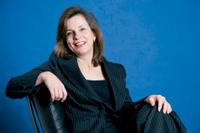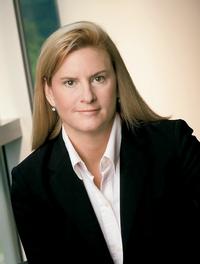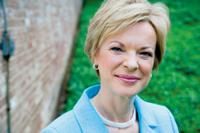
To get a sense of how women are doing in Washington, look at the White House.
President Bush has had two women, besides his wife, as trusted advisers: Secretary of State Condoleezza Rice, one of the world’s most powerful women, and Karen Hughes, the former White House counselor now at the State Department. Both have a long history in Bush’s inner circle.
At the same time, Bush lags behind his predecessor in the number of women appointed to key positions in his administration, according to an analysis by Newsday. Women have won 36 percent of the plum jobs in this administration; 44 percent of Clinton’s top appointees were female.
The White House is emblematic of the paradox Washington women face. Individual women—like Rice, retired Supreme Court justice Sandra Day O’Connor, associate justice Ruth Bader Ginsburg, and House minority leader Nancy Pelosi—have achieved lots of success here. But a giant leap for one woman hasn’t translated into steady steps upward for womankind.
“Organizations and institutions promote a few smart high achievers, and then the gate closes,” says Patricia McGuire, president of Trinity University and one of only two female university presidents in the Washington area. (Charlene Drew Jarvis is president of DC’s Southeastern University.)
Where are women doing well? As career civil servants and appointees in government. Across the board, the federal government has become such an exemplary employer of women that we could fill our entire list of 100 powerful women with those in high-level positions.
Women have flourished, too, in broadcasting, medicine, and the arts.
Three of the four major network bureau chiefs here are female, and women dominate cable and public broadcasting.
Where women used to be relegated to handmaiden status in medicine, they now head four of the institutes at the National Institutes of Health.
At one time, works by female artists were so scarce in Washington museums that local collector Wilhelmina Holladay founded a museum dedicated to women in the arts. Today, women head three of the Smithsonian museums.
But these successes make the absence of women at the top in other fields all the more striking. Where are the female newspaper editors, bank presidents, school superintendents, corporate CEOs, and elected officials?
Women fill two of DC’s top elected offices: Linda Cropp chairs the DC Council, and Eleanor Holmes Norton is DC’s congressional delegate. But suburban jurisdictions have few female county executives, mayors, chairs of county councils, city administrators, or heads of local school boards.
On the business front, only one of the area’s top 100 publicly traded companies is run by a woman. Dr. Martine Rothblatt heads the company she founded, United Therapeutics. Rothblatt is a transsexual who got her start as a male telecommunications lawyer.
“Women aren’t getting the assignments that allow them to cut their teeth as executives,” says Ericka Miller, director of Isaacson, Miller, an executive recruiter for universities and nonprofits. She says women need more mentors and better networks. Miller, who credits former DC school superintendent Floretta McKenzie with being her mentor, finds hope in the increasing number of women coming up in engineering and other male-dominated fields.
Corporate consultant Rebecca Shambaugh specializes in helping women reach the “C suite,” where CEOs, COOs, and CFOs dwell. Shambaugh says women often defeat themselves in the competitive corporate environment. She counsels not to expect recognition and promotion just for a job well done. “You have to develop strategic relationships with the right people,” she says. “Spend 20 percent of your time getting out, taking people to lunch, making contacts.”
Many women tend to focus on their individual assignment rather than the company as a whole, says Shambaugh. And pursuing perfection—even if it means doing everything yourself—leads many women to burn out before they get to the executive suite.
Some women have opted out because they can’t see combining motherhood with the 60-hour workweeks required by many top jobs. “There are all these former Supreme Court clerks who are now working on the auction at my daughter’s nursery school,” says one Washington mother.
Other highly educated young women, not wanting to bow to the demands of corporations and other large organizations, are choosing less traditional career paths. Georgetown law graduate Julia Lichtman Kepniss and Yale MBA Carin Rosenberg Levine decided to skip the law and corporate route and recently opened Hitched, a bridal boutique in Georgetown.
On the plus side, some of Washington’s best and brightest women are using their power positions to promote other women. Senator Hillary Rodham Clinton’s chief of staff, legislative director, and communications director are women. Half of the senior officials serving under Secretary Rice are women. At Discovery Communications, 45 percent of the executives working with company president Judith McHale are female.
But they are the exceptions.
“Women haven’t lifted as they climbed,” says Patricia McGuire. Shambaugh also sees the need for stronger women’s networks. “Women need to advocate for one another,” she says. “We need to be looking at all levels for women we can pull up.”
What difference does it make if people in power are men or women? The actions of decision-makers are often based on their own life experience, women leaders say. Phyllis Greenberger, president of the Society for Women’s Health Research, recalls that women weren’t included in federally funded medical research and were kept out of clinical trials until women fought for leadership roles in health agencies and began serving on the peer-review committees that consider research proposals. As a result, almost all medical research was based on the false assumption that the only difference between the sexes was in their reproductive systems.
“We’re still playing catch-up,” Greenberger says. Recent studies have highlighted different symptoms and treatment outcomes for women with heart disease and the fact that women face greater risk from lung cancer than men do.
The good news: Nearly half of the 2005 medical graduates were women. Women are gaining more positions on medical-school faculties. And women’s-health advocates have found powerful friends in the growing women’s caucus in Congress.
What does it take for a woman to succeed and lead? Here are eight whose achievements inspire young women to aim for the top. They have done more than break glass ceilings—they’ve defied the stereotype that women have to give up marriage and family to achieve professional success. Seven of the eight are married.
NAN ARON
The court’s counterpuncher
Conservatives call it “Aron’s Army.” Nan Aron, 58, is the founder of the Alliance for Justice, a coalition of 75 public-interest and civil-rights groups that works on issues ranging from abortion to the environment. But the alliance is best known for its advocacy on judicial appointments. Its most public victories were helping to defeat the nomination of Robert Bork for the Supreme Court and the successful appointment of Roger Gregory, the first African-American judge on the Fourth Circuit.
Aside from its Judicial Selection Project, Aron’s group is working to increase foundation support for nonprofit groups, offering technical assistance to advocacy organizations, and promoting youth leadership. In 2004, the Alliance started Coaches Against Gun Violence in eight DC high schools to get adults who are respected by kids to talk about preventing teen shootings.
Aron started the Alliance in 1979 with a small grant and support from 20 public-interest groups. She had been a trial attorney for the Equal Employment Opportunity Commission and a litigator representing prisoners for the American Civil Liberties Union. “Many conservatives were challenging the gains we’d made,” Aron says. “We needed a community of organizations to take on the right wing and big corporations.”
Organizing the opposition was second nature to the descendant of a long line of social activists in New York. “My grandmother went around the country raising money and lecturing about Israel, and many of my aunts were part of the civil-rights movement,” she says. “There was a lot of discussion around the dinner table about social causes.”
Aron met her husband, Bernard Arons, at Oberlin College: They were classmates, and seating was alphabetical. Arons is a psychiatrist who practices in New York and comes back to DC on weekends. They have three grown children—a son who’s a lawyer, a daughter getting a doctorate in psychology, and another daughter who works with people with HIV/AIDS in DC.
Case Western Reserve law school equipped Aron with the skills she needed to follow in the family footsteps. “It’s a catalytic profession. You can help improve policies that improve people’s lives,” she says. But while litigation is head-to-head combat, social advocacy requires the cultivation of allies. “You have to be a networker, work the phones, write letters, build an army.”
That coalition is even more important now, Aron believes. corporations feel more empowered in GOP-dominated Washington and law firms seem less eager to take on pro bono cases, she says: “The legal establishment has moved to the right.”
But not Nan Aron. Sean Rushton, who heads the conservative Committee for Justice, says, “Nan is viewed as an effective advocate for her side, someone willing to stage a debate anywhere, any time, as a vigorous proponent for her side’s point of view.”
When the Wall Street Journal called her the Madame DeFarge of liberal court watchers, Aron had only one complaint about the reference—she’s much too busy to take up knitting.
PATRICIA MCGUIRE
Helping a university make the grade
When Pat McGuire graduated from Northeast DC’s Trinity College in 1974, she never dreamed she’d come back 15 years later as the college’s president. If she were going to be an academic, she figured she’d teach at a law school.
McGuire, 53, had gone to Georgetown Law Center and become deeply involved in its DC Street Law Project. Law students were teaching DC high-school kids about the law and the legal system. The idea was that the more kids knew about the legal system, the less they’d want to run afoul of it.
After McGuire graduated, she stayed at Georgetown to run the street-law program. When federal funding for the program was cut, GU’s law dean told McGuire she’d have to raise the money to keep her program going. “I don’t do development,” McGuire said. But before long she proved so effective as a fundraiser that she was asked to become director of development for the entire law school.
The development job gave her the skills she needed when Trinity came calling, asking her, at age 36, to be its president. “I learned how to ask for money, how to cultivate prospects without appearing to have an agenda, and the social skills needed in business,” McGuire says.
In 1989, Trinity needed all of McGuire’s skills and more. The first Catholic liberal-arts college for women had been through six presidents in eight years, was no longer attracting the daughters of the upper-middle class that had been its mainstay, and had a campus and a reputation in need of repair.
“We didn’t know how to tell our story,” McGuire says. “I had to convince people inside Trinity as well as outsiders.”
First McGuire promised annual raises to the staff. Then she authorized $20,000 to paint the dome of the main building. “We needed a sense of pride,” she says.
Then McGuire did more than tell the Trinity story. She rewrote it. Today, Trinity serves mostly minority women who would otherwise not have access to higher education. The innovative weekend college and programs linked to the educational and business communities offer opportunities to students with limited time and money.
“As a university president, you have to be an entrepreneur,” McGuire says. The new $20-million Trinity Center for Women and Girls in Sports provides NCAA athletic opportunities for students and partnerships with groups like the Girl Scouts and Washington Hospital Center’s cardiac-rehab program. It also generates income from the community through its fitness center.
That humility comes with a down-to-earth manner. While other college presidents get mansions, drivers, and entertainment allowances, McGuire, who is single, lives modestly, drives herself, and doesn’t even have a president sign in the parking lot. For Christmas last year, the faculty gave her something she really wanted—a new orange traffic cone to reserve a space for her in front of the main building.
JUDITH MCHALE
Discovering secrets to success
In 1987, when Judith McHale left New York and a job as legal counsel at MTV to go to the tiny Discovery Channel in Landover, Maryland, most of her friends thought she was crazy. MTV was the hottest network on cable, and Discovery, back then, had 35 employees and an uncertain future. John Hendricks had originally called the company the Cable Educational Network. But even with the new name, Discovery seemed like a snooze.
McHale signed on as the only lawyer but helped shape the fledgling enterprise as it launched Discovery in Europe and acquired the Learning Channel. At Discovery, McHale worked closely with founder Hendricks and president Ruth Otte. Still, she felt hamstrung by her legal label. “Don’t think of me as just as a lawyer,” McHale told Hendricks and Otte. “There are other things I can do.” The general counsel was soon in charge of human resources and information technology.
She’s a lot more than a lawyer now. Named president and chief operating officer in 1995 and CEO in 2004, McHale runs a global media and entertainment company that includes the Travel Channel, Animal Planet, Discovery Health Channel, the Nature Company stores, Discovery Channel stores, and an alliance with the BBC. Discovery has 6,000 employees and operates in 160 countries and territories, reaching 1.3 billion subscribers.
McHale says that in its early days cable television offered more opportunities for women than network TV because it was seen as a risky business, and women were willing to take the risk. The secret of her own success? “If you’re interested in doing other things, raise your hand. It makes people look at you differently.”
When Discovery had a major programming position open up, McHale was surprised that no women applied. She learned that many women thought that if they were qualified for the job, a manager would have asked them to apply. “Have confidence to take the first step,” she advises.
A working mother, McHale makes it easy for women to combine work and family. Discovery’s work/life initiative provides flexible hours and lots of opportunities to work from home. A Women’s Leadership Group offers guidance on coping with a career and a newborn. Discovery is often on lists of best companies for women—and men.
But McHale would not have stayed at Discovery for its enlightened culture alone. “A job should not just be a paycheck, it should be a passion,” she told the American University graduating class of 2005.
And it shouldn’t be an unrequited love affair. “Don’t stay in an organization that is not meeting your goals and objectives,” McHale says. “Find an organization that really works for you.”
LINDA CROPP

Her chessboard is the city
For Linda Cropp, 57, politics began at home.
A social-studies teacher and later guidance counselor at DC’s Eastern High School—whose husband also taught there—Cropp was determined to keep her children in DC public schools even though she was dissatisfied with the neighborhood school, Powell Elementary School in Ward 4. Cropp got so involved in the PTA that after DC got home rule, neighbors encouraged her to run for the ward’s seat on the new board of education. She won in 1981, when Floretta McKenzie was the new school superintendent.
Student test scores were rising, but school buildings were falling apart. “We demanded that Mayor Barry replace 100 roofs on schools,” Cropp recalls. “We sued him, and we won.”
Cropp became head of the school board in 1987 and four years later won a seat on the DC Council. In 1997, she became council chairman. She has no problem with the “man” in the title. “It’s ‘chairman’ by act of Congress and signed by the President as part of the home-rule legislation,” Cropp says. “They never thought a woman would be in this position.”
Her chairmanship began when the city grappled with unbalanced budgets, junk bonds, and the financial control board. “We have a cash reserve now, and I’m not about to let this city turn around again,” she says.
Cropp describes herself as a consensus builder rather than a crusader—a leadership style that has left her open to criticism. She admits she’s had to use her old skills as a teacher and guidance counselor to keep the council moving forward. “Consensus doesn’t mean you lack vision,” she says. “Until you get other people to buy into your position, you cannot move forward.”
On a council with 13 strong personalities, controversial issues, and several members running for council chair or mayor—including Cropp—consensus can be elusive. Her secret of success: Play chess instead of checkers. “You have to look out five moves ahead,” she says.
And Cropp is not afraid to go it alone. When she felt Mayor Anthony Williams hadn’t cut a good enough deal with Major League Baseball, Cropp dug in her heels until both sides agreed to more private funding for a new stadium. The headline in the Washington Post the next day read, at the end of the day, cropp owns the deal.
OLGA VISO

The art of following your passion
At 39, Olga Viso would qualify as a “woman to watch” but for the fact that she isn’t on her way to the top—she’s already there. Ten years after coming to the Hirshhorn as an assistant curator, Viso last year was named director of the museum. She has turned a childhood passion for making art into an adult passion for nurturing and celebrating artists. “This museum is dedicated to encouraging and exhibiting the art of our time,” Viso says.
Viso grew up in Florida, the only child of Cuban immigrants. Her mother had had her own business but had to start from scratch when she emigrated here. “She always encouraged me to be respectful, disciplined, but a free thinker,” Viso says.
At Rollins College in Florida, Viso proved herself as entrepreneurial as her mother. While studying art and business, Viso asked permission to exhibit works by students and faculty in the campus library. “I did six or seven exhibits there a year,” Viso recalls. By this time, she had concluded that she lacked the talent to be a professional artist.
After graduation, Viso tried marketing for a development company but wasn’t happy. From there, she went back to school for a master’s in art history at Emory University in Atlanta. She also started working at Atlanta’s High Museum of Art and stayed on after graduating. In 1993, Viso moved to the Norton Museum of Art in West Palm Beach, where her interest in contemporary art and living artists flourished. She was specifically qualified to curate the exhibit that brought her national acclaim—the work of four female Cuban artists called “Transcending the Borders of Memory.” Two years later, Viso came to the Hirshhorn as an assistant curator.
As curator for contemporary art, Viso led the museum’s Directions program to showcase emerging artists. She has expanded the museum’s reach to include artists from Asia and Latin America. “We have an opportunity and a responsibility to be even more global,” she says.
Viso says being young has been more of a barrier than being female: “I’ve had to be more persistent. I’ve also had exceptional mentors, mostly men, who gave me encouragement.”
Her relationship with the other Olga—Olga Hirshhorn—is also close. “The Hirshhorns had a strong personal relationship with artists,” Viso says of the museum’s founders. Olga Hirshhorn’s highest accolade about an exhibit: “Joe would have liked this.”
What does it take to succeed in the arts? Viso has followed her mentors’ advice to network and be visible. She gives lectures and gallery talks all over the East Coast, writes for scholarly publications, and is active in international arts organizations.
When her appointment was announced, she started hearing from women. “I symbolize a shift for women, particularly for Latina women,” Viso says proudly.
NANCY DORN

An alpha female in a field of alpha males
Nancy Dorn arrived in Washington in 1981 with $1,000, seven cartons of stuff, and no job. The Texas native had been working on small-town newspapers but says, “I wanted to make news rather than report it.” Dorn, 47, started knocking on congressional doors and landed a job as a press assistant to Tom Loeffler, a Republican congressman from Texas. Six years later Loeffler ran for governor and lost, but Dorn had earned enough political points to move to the Reagan White House as a special assistant for legislative affairs.
A few years later, at age 33, President George H.W. Bush nominated Dorn to be the first woman and the youngest person to serve as an assistant secretary of the Army, heading the Corps of Engineers. How did a young female civilian deal with the senior military officers?
“I was not a known quantity in the Pentagon. I had a one-star Marine general who was supposed to work for me,” she says. “It took a few months before he realized that I had a wealth of experience in the legislative and executive branches. I had come from the White House. I had connections to the Secretary of Defense.”
Dorn’s secret of success: Bring something to the table. The corps had been having problems with the Office of Management and Budget. Dorn may not have known how to build steel bridges, but she did know how to build personal bridges among the Pentagon, the OMB, and Congress. As a result, the Corps of Engineers broadened its mission to include environmental cleanup.
When Bush left office in 1993, Dorn joined a lobbying firm. It was a welcome break for the young mother. “Being out of power, you have time to do things with your kids,” she says. But by 2000, when House speaker Dennis Hastert beckoned, Dorn was ready to go back. She worked for Hastert on foreign policy and defense issues, then moved into a new Bush administration, first as an assistant to Vice President Dick Cheney for legislative affairs and then as deputy OMB director.
But demanding administration jobs didn’t leave her much time to spend with her preteens. “If you’re lucky, you have choices,” she says. When she was offered the job of running General Electric’s Washington office, she took it.
Washington is a good town for “alpha females,” Dorn says. “Look at Condi Rice—she is so far from being a token.” So is Nancy Dorn.
CATHERINE WEST

Banking on the right priorities
Catherine West, 46, did not grow up dreaming of dollar signs. She got her first job at Chevy Chase Federal Savings Bank in 1984 because the bank had a solid reputation, offered a training program, and was located near her ailing father.
West, a Washington native, had just graduated from Lynchburg College. “I went in as a young girl, and Lynchburg touched my soul for four years,” she says. “I came out a confident woman.”
It was a heady time for young women. Geraldine Ferraro had just been nominated for vice president. “I had a sense I could do anything I put my mind to,” West recalls.
It was a heady time for Chevy Chase Bank, too. The bank was starting its first credit-card program, and West was one of the first three people hired. Being part of a start-up fueled her enthusiasm and ambition. Six years later, West was vice president of the bank’s credit-card serving operation, handling nearly $5 billion in managed loans. She moved to First USA Bank in Wilmington, Delaware, and joined Capital One in 2000.
In 2004, she became president of US Card, the largest division of Capital One Financial. She directs all product, marketing, and consumer-service activities for more than $48 billion in managed loans and $7.9 billion in revenues. Capital One is the last company she’ll ever work for, she says: It has a culture that “promotes women and diversity of thought.”
West’s secret of success: “It’s the company you keep. Seek out the kind of company where you can succeed, a company on a growth trajectory.”
West’s own idea of success changed when she became a mother. When her son, Will, was born nine years ago, West was working in Wilmington and returning to Chevy Chase most weekends. When she went into labor, she drove herself to the hospital and kept working on bank business until she was wheeled into the delivery room.
She took six weeks’ maternity leave. But after six months of juggling motherhood and management, she realized something had to change. At home in Wilmington one Saturday night when she and the baby were sick and her husband out of the country, she got a call from her boss at 10 o’clock asking her to come into work. West wrapped up the baby, went to the office, and asked a friendly security guard to keep an eye on Will.
After about an hour, West realized the absurdity of the situation. She picked up her baby and walked out and says she has never gone back to her workaholic ways. “A child helps you get your priorities straight,” she says. “It has made me a better person.”
And, she believes, a better manager. What impresses people who work for her most? “The fact that I’m a good mother,” she says.
ELIZABETH NABEL

Following her heart to medicine and the top of her game
Growing up in St. Paul, Betsy Nabel was fascinated by her father’s work as a scientist for the 3M Company. An inventor of ScotchGuard, he made research sound like an exciting voyage of discovery. But Nabel, 54, was a girl in a traditional Scandinavian family in Garrison Keillor country; nobody encouraged her to follow her father’s path. She went to St. Olaf’s College and studied psychology.
After graduation in 1974, Nabel left Minnesota to study at Columbia University. “Manhattan was the place to be,” she says. Ms. magazine was energizing women. Nabel realized she wanted to study medicine and enrolled in Cornell Medical School. One-third of her classmates were women.
At Cornell, Nabel first thought she wanted to be a surgeon. But she had heard about the treatment another female student had suffered from the head of surgery so instead chose cardiology. A stint in Africa working with volunteer doctors confirmed that she had made the right career choice. “I knew that I was using medicine to improve people’s lives.”
Nabel was back in the States doing a residency at Harvard-affiliated Brigham and Women’s Hospital when she met her husband. Gary Nabel was her intern, and she was reluctant to date him. But he won a bet with her about a patient’s diagnosis. The prize: dinner.
Their first child was born in the second year of a cardiology fellowship at Brigham and Women’s. Nabel smiles as she describes carrying breast milk in the same Igloo coolers used to transport hearts for transplantation.
When both had finished their training, the doctors Nabel were offered jobs on the faculty of the University of Michigan Medical School. Betsy was director of the Division of Cardiology, doing research in vascular biology and molecular cardiology, when the National Institutes of Health asked Gary to head the Vaccine Research Center in the National Institute of Allergy and Infectious Diseases in Bethesda.
“It was the opportunity of a lifetime,” Betsy says. But the Nabels insisted that they were a team—they wouldn’t move unless both were offered challenging opportunities—and NIH came through in 1999, making her scientific director of clinical research for the National Heart, Lung, and Blood Institute. She started a cardiothoracic surgery branch and began to investigate the genetics of vascular diseases.
When the Institute’s top job opened, Nabel went after it. Her secret of success: Be bold. “It’s common for men to talk about their accomplishments,” she says. “It’s important to show our colleagues that women can be equal contributing partners.” She was named director of NHLBI in 2005.
Nabel has a budget of almost $3 billion, a staff of 850, and responsibility for research all over the country. She also has a bully pulpit—one she is using to tell women about their risk for heart disease. “Now we know that coronary artery disease kills more US women each year than all cancers combined.”
She also seeks to be a role model, which has had interesting consequences on the home front. When her five-year-old son was asked what he wanted to be when he grew up, he said, a cell doctor. “Only girls are heart doctors,” he added.


















